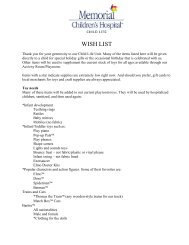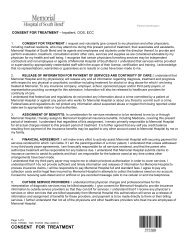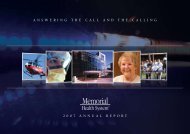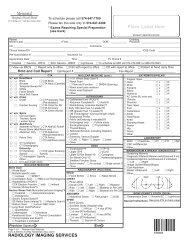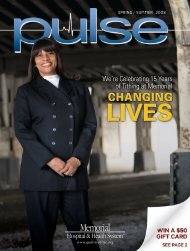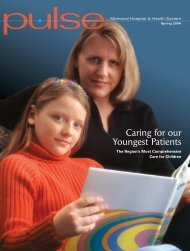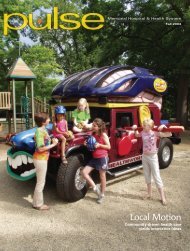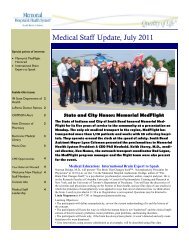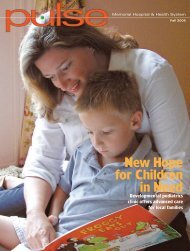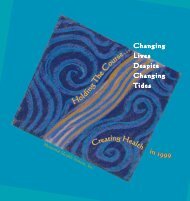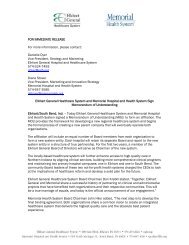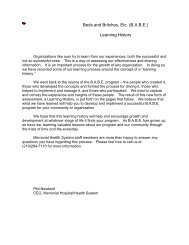Spring 2013 - Memorial Hospital of South Bend
Spring 2013 - Memorial Hospital of South Bend
Spring 2013 - Memorial Hospital of South Bend
You also want an ePaper? Increase the reach of your titles
YUMPU automatically turns print PDFs into web optimized ePapers that Google loves.
Vaughn honored the football coaches, many <strong>of</strong> whomshe has known since she was a young girl, with anAmerican Heart Association ® Heroes Award in October.She plans to take a CPR course so she can pay forwardthe gift <strong>of</strong> life that started with her sons’ coachesknowing what to do that day.“If it was going to happen, I’m glad it happened the wayit did, or I wouldn’t be here,” says Vaughn, who turned30 in September. “I have definitely changed as a personand appreciate the little stuff.”The Biggest Advancement Since CPRSince 2006, the survival rate among patients broughtto <strong>Memorial</strong> after suffering ventricular fibrillation, asVaughn did, is almost 73 percent. Nearly all returnedhome within three to five days <strong>of</strong> admission with little tono long-term neurological problems. By contrast, a fiveyearstudy published in 2011 by the Centers for DiseaseControl and Prevention placed the overall survival rateat just above 30 percent for patients like Vaughn. “Thisis the biggest advancement in resuscitation medicine indecades, possibly since the advent <strong>of</strong> CPR more than50 years ago,” Seifert says.<strong>Memorial</strong> was a leader in implementing the hypothermiaprotocol locally in late 2006. Emergency physicians andEMS medical directors Keith Sherry, M.D., and BruceSpeicher, M.D., and Gary Fromm, M.D., medical director<strong>of</strong> <strong>Memorial</strong>’s ICU, championed the cause, whichrequired the support <strong>of</strong> both local hospitals to ensurethat the benefits <strong>of</strong> therapeutic hypothermia areavailable to everyone in this area. Drs. Sherry andSpeicher then reached out to the EMS community inSt. Joseph County, authorizing the procedure forstarting the protocol in the field. Almost alladvanced life support ambulances in St. JosephCounty now have refrigerators on board thatcontain the cold saline needed to begin thecooling process, which is continued onarrival to the Emergency Department.Therapeutic hypothermia is a valuableand powerful tool in promotingneurological recovery in victims <strong>of</strong>cardiac arrest who are successfullyresuscitated. However, health carepersonnel and the American HeartAssociation continue to emphasizethe importance <strong>of</strong> high-quality CPRand early defibrillation to givepatients a chance <strong>of</strong> resuscitationand an opportunity to benefit fromtherapeutic hypothermia.Tough Call Wasthe Right CallUse <strong>of</strong> the hypothermia protocol on pregnant womenhas not been widely embraced because <strong>of</strong> a lack <strong>of</strong> dataabout how it affects the fetus.But one February night in 2009, <strong>Memorial</strong> emergencyphysician Rajalakshmy Sundararajan, M.D., inconsultation with other physicians, made the tough callto use the technique on 33-year-old Cindee Goodling, whowas 20 weeks pregnant and had been resuscitated from aprolonged cardiac arrest in a local church. This is particularlysignificant in light <strong>of</strong> a recent study presented at theAmerican College <strong>of</strong> Cardiology that indicated changesbrought about by pregnancy can increase a woman’srisk <strong>of</strong> heart attack during pregnancy. High-quality CPR,provided by community members prior to the arrival <strong>of</strong>paramedics, was also an important factor in her successfulresuscitation.Not only did both mother and baby survive, but Goodlingwas back to work within days after leaving <strong>Memorial</strong>. Fourmonths later, she gave birth to a healthy baby boy, Collin,now 3 years old. During resuscitation, Goodling was alsoshocked several times. In a fitting recognition <strong>of</strong> this,Collin’s nickname is “Zap.” During EMS Night at CoveleskiStadium in 2011, Goodling and Zap threw out the firstpitch in appreciation <strong>of</strong> all those who had made theirsurvival possible.Goodling’s story was featured on MSNBC’s websiteand documented in an article in the international journalAnnals <strong>of</strong> Emergency Medicine, collaboratively authored byAakash Chauhan, M.D.; Harsha Musunuru, B.S.;Michael Donnino, M.D.; Michael T. McCurdy, M.D.;Vinod Chauhan, M.D.; and Mark Walsh, M.D.Simple Steps That Can Save Your LifeTake a free, confidential risk assessment that couldsave your life or greatly improve your quality <strong>of</strong>life. Go to whatsmyrisk.org, where you can learnmore about your health and whether you’re at riskfor conditions such as heart disease, joint pain,diabetes, sleep disorders, obesity and stroke. Eachassessment is quick and easy. If you are at risk, call800-647-6800 to speak with one <strong>of</strong> The HealthPr<strong>of</strong>essionals at <strong>Memorial</strong> <strong>Hospital</strong> <strong>of</strong> <strong>South</strong> <strong>Bend</strong>.<strong>Spring</strong> <strong>2013</strong> | quality<strong>of</strong>life.org9




